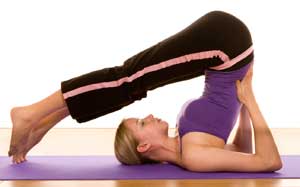“Are Some Yoga Poses More Harmful Than Helpful?” generated a flood of comments from readers wanting to share their experiences and explore the benefits (and potential hazards) of other common poses. Here are some follow-up answers from author Megan Segner and her team of yoga experts.
Q: Headstands are considered contraindicated in the fitness community, and I believe that the cervical spine is far too fragile for most individuals [to properly perform this pose]. Are there modifications for those who would like to build up to headstands?

A: In a yoga headstand, your body weight should be supported by the muscles of your upper body and not your cervical spine, says Dr. Eden Goldman, D.C., a chiropractor, co-founder of Yogadoctors.com, and co-director of yoga teacher training at Loyola Marymount University in Los Angeles. He notes that a headstand is an advanced pose, which may require up to a year or more of preparatory training. “Just like in fitness, don’t start clients with the hardest variation.”
Ideally, only 10 percent of your weight should rest on the crown of your head, he explains, with the remainder supported by the muscles of the shoulders, arms, upper back and chest. Because poorly performed headstands can excessively load the cervical spine, progressions should be limited based on strength and body awareness. Goldman recommends push-ups, handstands, free-weight exercises, and the dolphin (a yoga pose that looks like a piked fitness plank) to build the required upper-body strength.
Advanced practitioners with the requisite muscular development, proprioceptive ability and hamstring flexibility can try performing a bound headstand (baddha hasta sirsasana): Lightly place the crown of the head on the floor about 2 inches away from a wall. Cup both hands around the back of the head, with forearms flat to the ground. Tuck the toes, extend the legs and lift the hips to dolphin pose, shifting the majority of body-weight onto the forearms, triceps and deltoids. Tip-toe the feet forward so the hips stack over the shoulders. Engage the core muscles, bring the knees to the chest, and slowly extend the legs overhead (never “kick up”). Continuously activate the upper-body muscles and press down through the forearms—avoid “sinking” passively into the posture to protect the neck.
Q: I don't understand Dr. Weiss' comment—how can you perform a yoga plow without the thoracic vertebrae touching the floor?

A: In a yoga plow, your body weight should rest on the back of your shoulders and triceps while your spinal extensors subtly lift your thoracic vertebrae upward. Your elbows should be close together so that your arms and shoulders create a supportive “ledge” that takes your body’s weight. Think of the plow as an active “lifting” posture, rather than a passive “collapsing” or resting pose.
Dr. Steven Weiss, M.S., D.C., a trainer of yoga instructors and chiropractor with AlignbyDesignYoga.com in Sarasota, Fla., recommends a “pencil test” to determine correct alignment. “[When your client is in plow], a pencil should be able to slide between the bottom of the neck and out between the shoulder blades.”
The proper alignment of the shoulder blades is what allows the upper back to correctly extend so no portion of the spine is required to support the pose, adds Weiss. He uses the following sequence of cues to teach students to “soften” the mid-traps and allow the scapulae to translate toward the spine in plow pose:
- Lengthen the rib cage and sides of the body.
- Broaden the chest from under the clavicles to help prevent forward shoulder-roll.
- Draw the humeral heads deep into each glenoid fossa.
- Broaden the clavicles as the shoulder blades translate toward the spine in a one-to-one direct rate relationship to each other.
- Externally rotate the humeral heads.
- Draw the tips of the shoulder blades toward the ribcage using the lower portion of each serratis anterior.
A full yoga plow demands flexibility, body awareness, muscular strength of the upper body and core, and mental patience. In other words, it is not a pose for beginners. Novice-level progressions can include seated or standing forward-fold (hip flexion) variations.
______________________________________________________________

Megan Senger is a writer, speaker and fitness sales consultant based in Southern California. Active in the exercise industry since 1995, she holds a bachelor’s degree in kinesiology and English. When not writing on health and lifestyle trends, techniques, and business opportunities for leading trade magazines, she can be found in ardha uttanasana becoming reacquainted with her toes. She can be reached at www.megansenger.com.